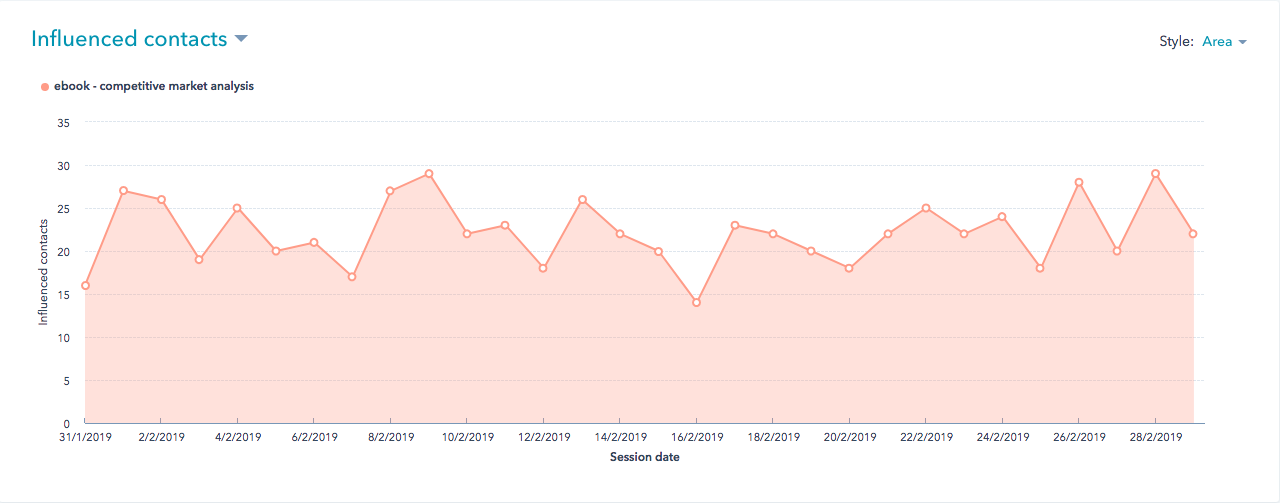
Get weekly
HubSpot updates
What is a good digital marketing campaign?
Whether it's your first digital marketing campaign, or you're an experienced marketer, starting a new campaign has to yield results that ultimately fill your sales pipeline. After-all, marketers have spent years finding a way to report on their success in monetary values. It’s why we use HubSpot among our analytics tools in order to prove the value that we deliver as an inbound agency.
The goal of your marketing has to be proving how a marketing plan supports your sales team in achieving their goals. For the majority of our clients in the SaaS industry, their goal is to grow their monthly retained revenue through a high converting sales pipeline.
There are of course many touch points across the buyer's journey. From becoming aware of their problem to making a decision on who they trust enough to solve their problem, and reward with their custom. That is why a good online marketing campaign has several key performance indicators (KPIs) that are also highly important for measuring how successful your marketing efforts have been.
The digital marketing KPI’s include
- Website traffic
- Conversions
- Enquiries
- Email open and click rates
- Ads performance
- View-to-contact conversion rate
- Contact-to-lead conversion rate
- Lead-to-sales opportunity
Find more information on metrics here: {link to our metrics blog post)
It’s therefore vital that your goal is clear before you start your new digital marketing campaign. You absolutely must know what it is you are setting out to achieve so that you can take the following steps outlined in this article. This will ensure that when you ‘flick the switch’ and turn your next digital marketing campaign on, it’s ready to fulfill that purpose.
How do you write a digital marketing campaign?
What’s in a marketing plan?
Your marketing plan is an essential document that outlines everything you and your team will need to do to sell your product or service. If you're going to run successful marketing campaigns, a solid plan is going to increase your chances of customers coming onboard.
It is highly recommended by any marketing industry expert these elements are in your plan:
- Goals & KPIs
- Research & competitor analysis
- Audience setting & buyer personas
- Value proposition
- Strategy
- Delivery
- Reporting & optimisation
We have already mentioned goals and KPIs above and we will refer to these as we cover the rest of what your marketing plan is going to contain.
Research and competitor analysis
Don’t underestimate the power of good research, or forget that research must be updated periodically. One of the biggest mistakes we see are marketing plans based on out of date research. As the world around us changes due to technological influences, world events and new buying habits, it’s important to regularly update your research.
What do you need to research for a digital marketing campaign?
Your market research wants to ensure that you have an understanding of what questions your buyers are asking and what your competitors are doing—or even better not doing—to answer those questions. When we complete our market research for new clients as we build their marketing plan, we are always looking to find ways to solve problems for their prospective buyers.
Why?
Because people want their problems solved for them. They don’t want X or Y service, they want their lives to be problem free. If you can show them how to achieve that then your business naturally becomes part of the solution conversation.
“as consumers, we’re too busy to pay attention to advertising,
but we’re desperate to find good stuff that solves our problems.”
― Seth Godin, Purple Cow: Transform Your Business by Being Remarkable
To learn how to understand what these questions are and the problems they allude to, you have to know what your buyer persona looks like and what their journey is, from becoming aware of a problem to deciding on what the best solution is for them.
Your buyer persona is a semi fictional character that you create for your business, and throughout the development of your marketing strategies you will return time and time again to this document.
[insert example image of buyer persona document]
What is in a buyer persona?
Demographics - Age, Sex, Marital Status, Geographical location
Role specific information - Job Title, Seniority, Accountabilities
Business motivations & pains - Growth, Compliance risks
Personal information - Where they network, Peers, who they learn form
Personal motivations - Become a published author, Public speaker, promotion, awards
A defined buyers journey
As well as understanding the buyer you need to understand your market place. Who are your competitors and what are they offering to the buyers?
For example, if competitor A has a blog that is regularly updated and maybe has a blog post that is shared around on social media by other industry commentators, then that is something you need to know about. Why is that content popular? What question is it answering and what problem is it solving?
You can also see what your competitors are not talking about. This can open up massive opportunities for your business.
If you know that the buyer has problem Y and is asking questions on how to solve it, yet no one is answering that question, then you need to be answering that question.
Of course, market research can go much deeper than this. But if you had to take away anything from your research it should always be what questions do prospects want answered.
To learn more about market research check out this article from entrepreneur https://www.entrepreneur.com/article/217388
Value Proposition and Digital Strategy
Once you have completed your research the real fun begins. This is where you're going to take everything that you’ve learned and work out exactly what value you as a business bring to your clients. You're also going to take your goals and define a strategy that meets those goals and the tactics that will get you there.
To work out value propositions I use a fairly standard template that can be completed thanks to my early research. Simply replace the orange words with your researched answers.
My business helps my client avoid pain and achieve desired outcome by my offering
That’s it! You don’t need anymore for your digital campaigns. Remember your campaigns are about your prospect not you, so you have to give them the desired outcome they want. That’s how you add value and become desirable!
Working out your strategy is not as easy, but there are plenty of proven strategies and digital marketing templates that work for a variety of businesses. If you're not sure then speak to a colleague who has had success, or an agency that specialises in your market. There are always people available to speak to that will help you work out the best marketing strategy for you. Whether you're looking to create brand awareness or generate high volumes of really good leads, you're going to need the right plan to make it a success.
I promised to show you how to start a digital marketing campaign that would fill your sales pipeline. So here is an example of a digital marketing strategy for a SaaS business that sells an account platform.
In this instance we know the following:
Our buyer is a business owner who is struggling to keep up to date with his accounting, and a major frustration is tracking employee expenses. This is impacting his productive time in the business, causing stress with his employees and taking the owner away from developing the business.
In the goals research we’ll have already identified the average ARR/MRR per customer and the number of customers we need to generate our target ARR/MRR outcome.
You will have also worked out how your existing lead sources are performing at the critical steps in your sales process.
These should be at the very least:
- Visitors to leads
- Leads to opportunity
- And sales converted.
You can now easily work out the impact of increasing the conversion rates, or the number of visitors you require to generate the right number of sales.
Let's say that you get great conversions on leads to opportunities through your email nurture programme.
A good strategy would be to increase the number of leads that are entering your email nurtures. This could be through a new content offer, stronger CTA’s on your website or a wider promotion for the source to entry into your nurture. Again, all you have to do is look at the numbers and your research to know exactly what your strategy will need.
Picking the tactics that will get you the desired result is again easy if you have done your research into where your buyers are gathering and learning. Content marketing is great at engaging buyers and attracting them to your website. This strategy takes time to deliver results, but the ROI is fantastic and only gets better with time. Imagine your blog post is on page 1 of the Google search results page (SERP) for relevant searches and you maintain that position for years. Each and every lead that converts will only help to improve the value of that blog to your business.
Don’t believe me? Marcus Sheridan is the author of They Ask You Answer and a blog he wrote years ago for his swimming pool company has recently hit a new milestone for the revenue it has generated for his business: $15million from one blog post!
If you need quick results then you want to explore ads that target the decision making stage of the buyer’s journey and build your organic traffic over time. These types of sales funnels are high converting, need to be constantly fed with funds, but achieve amazing ROI results that are highly predictable.
All of the above should also be underpinned with emails, ideally automated, that will then continue to nurture and bring prospects closer to you over time.
If you want more information on developing a marketing strategy, you can download our Guide to Marketing Strategy.
Reporting and optimisation
That’s right, more numbers and analysis. Getting a digital marketing campaign to be successful is rarely a set-it-and-forget-it option. Of course, you're more than welcome to accept the results you get the first time around. However we have proven over and over again for our clients that continuing to review the right metrics for your strategy make a difference.
Now, depending on the tactics you have deployed there will be various KPIs that you want to monitor. These could be cost per click if you're running PPC activities or free trial sign ups on the back of an email blast.
The key thing is to not get caught out by the rest of the data. Yes, how many likes and shares you get on social media is important and helps create brand awareness, but the more important numbers are the ones that directly affect your sales team.
The best digital marketing campaigns will always look at how they can increase your traffic, optimise your conversion paths and ultimately increase the number of sales appointments your team attends.
All you need to get started is to get to grips with the data that you need to make the right decisions.

